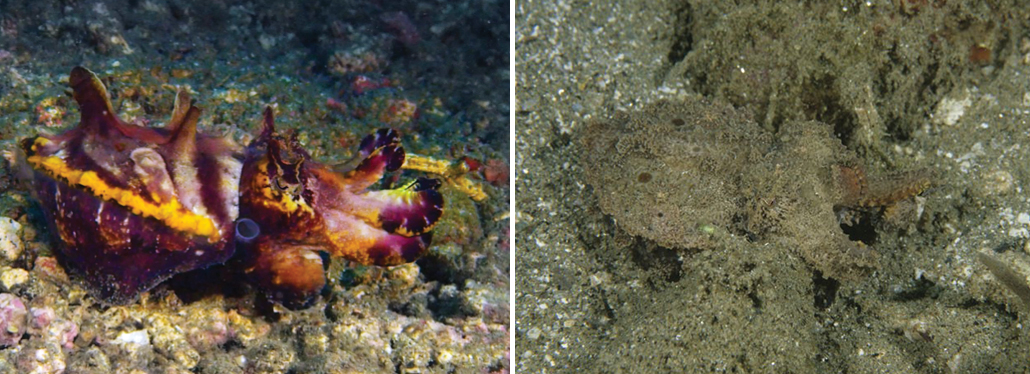
The flamboyant cuttlefish (Metasepia pfefferi) is known for its bright purple and yellow patterns. Recent field observations caught females laying 15 to 25 eggs at a time in coconut shells and suggest that the animals may either return to the same shell over and over again or share shells with other females.
Steven Kovacs/Biosphoto/Alamy Stock Photo
- More than 2 years ago
Don’t let the name fool you. Flamboyant cuttlefish (Metasepia pfefferi) look anything but flashy most of the time. Images and videos of the marine mollusks flashing bright purple and yellow hues litter the internet, perpetuating the idea that these animals are constantly putting on a show in the wild. But a new study proves just the opposite: Flamboyant cuttlefish spend most of their time looking like a pile of mud.
“These animals have superb camouflage,” says Roger Hanlon, a marine biologist at the Marine Biological Laboratory in Woods Hole, Mass. Specialized cells and structures in their skin allow the animals to instantly morph into ostentatious patterns, as well as blend in.
Keen to see how the animals balanced flamboyance with camo in nature, Hanlon organized two field studies in a cuttlefish habitat off the coast of North Sulawesi, Indonesia. Citizen scientist divers scouted the Lembeh Strait area over eight days in 2002 and again for 11 days in 2019, being careful to eavesdrop without disturbing the animals. Video footage collected by the team now reveals intimate details of the species’ mating practices and defensive behaviors as well as what the animals do in their downtime. Hanlon and Gwendolyn McManus, a marine biology student at Northeastern University in Boston, describe the results in the August Journal of Experimental Marine Biology and Ecology.
The solitary species slowly ambles along the seafloor, foraging in a drab region of mud and sand between coral reefs. “It’s like a moonscape or a desert,” says Hanlon. Flamboyant cuttlefish take on the color and texture of their muddy seafloor backdrop and masquerade as a lump of sand or a rock. Like some other cephalopods, these cuttlefish spend most of their time incognito, reserving their displays for special occasions: confusing a predator, courting a mate and sparring with rival suitors.

Flashing their good looks 24/7 would attract unwanted attention. But it comes in handy if their first line of defense — camouflage — fails. Then, both males and females will engage in a campaign of unpredictability. When confronted by a threat, the animal might quickly flash its colors to frighten the predator, sometimes in just 700 milliseconds. Next, it cycles through other confusing behaviors — jetting, shooting ink and reverting to camouflage — until it has eluded the enemy.
Males also show flamboyant displays to attract the ladies. After spotting a female in the distance, a male will flaunt bright colors and undulate their mantle stripes in a move called “the passing cloud.” Researchers also observed two types of gestures during this colorful routine: arm waving (reminiscent of a human bowing) and kissing (a tap on the female’s arm with his arms). “These displays are really elaborate and dynamic,” says Hanlon. “And they’re comparable to what some of the most sophisticated birds do and even some primates.”
Love triangles happen, and males sometimes guard females and fight off other males (SN: 5/12/17). In brawls, male body patterns split flirting and fighting. The side facing the female flashes the bright motif, while the side facing the male takes on an aggressive white pattern.
All of this pizzazz can put males at risk. Hanlon recalls an instance where a male swimming backward got scarfed up by a scorpion fish in the midst of his flamboyant display. “There’s the price you pay for displaying to a female not paying attention to where you’re going,” says Hanlon.
But the risk can come with reward — for some lucky guys. Eventually, a female may open her arms and mate for a quick three seconds. Figuring out exactly what flirting tactics a female uses to select her mate requires more data. “Does she focus on the male’s courtship dance? On his ‘kiss’ signal? Or on how bright his passing cloud is? It’s too soon to tell,” says Alex Schnell, a wildlife scientist at Cambridge University who was not affiliated with the study.
Males also got shot down a lot, as picky females appear largely unmoved by most of their showmanship. Of 108 kisses observed, only 20 led to something more. The observations hint that the most successful males might be the ones that worked the hardest and remained persistent.
The field observations fill in knowledge gaps about how these animals survive in the wild and contradict two previous studies in a lab and an aquarium, as well as photos and videos from scuba divers, that suggested that the animals displayed their flamboyant patterns more frequently. Looming humans, bright lights and higher density tanks may have shifted the behavior of a species that spends most of its time alone and under the radar.
Sign up for our newsletter
We summarize the week's scientific breakthroughs every Thursday.





